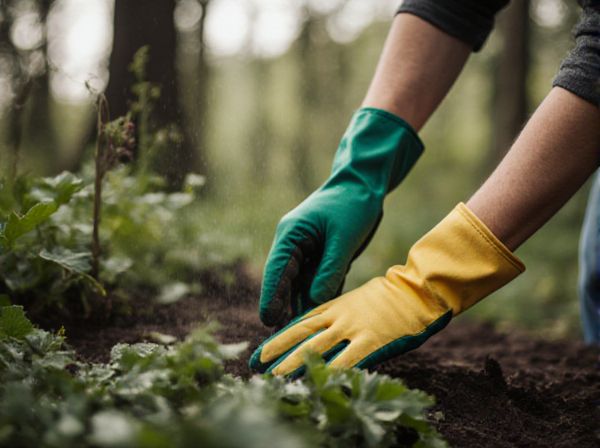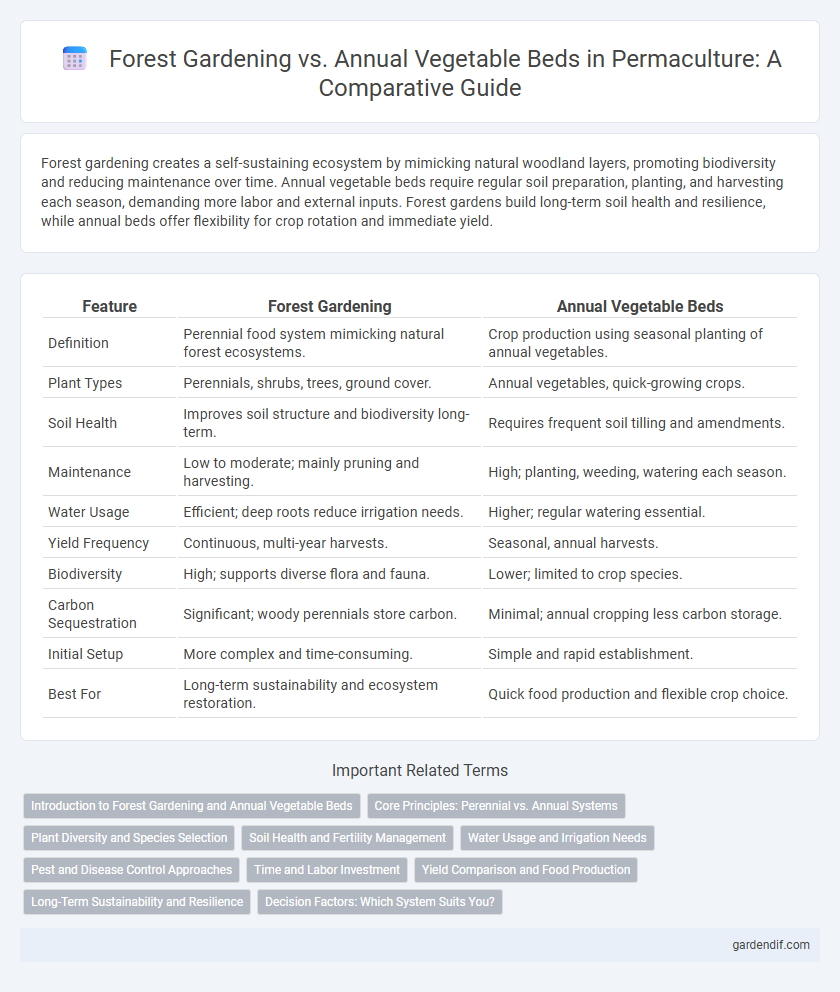
Forest gardening vs annual vegetable beds Illustration
Forest gardening creates a self-sustaining ecosystem by mimicking natural woodland layers, promoting biodiversity and reducing maintenance over time. Annual vegetable beds require regular soil preparation, planting, and harvesting each season, demanding more labor and external inputs. Forest gardens build long-term soil health and resilience, while annual beds offer flexibility for crop rotation and immediate yield.
Table of Comparison
| Feature | Forest Gardening | Annual Vegetable Beds |
|---|---|---|
| Definition | Perennial food system mimicking natural forest ecosystems. | Crop production using seasonal planting of annual vegetables. |
| Plant Types | Perennials, shrubs, trees, ground cover. | Annual vegetables, quick-growing crops. |
| Soil Health | Improves soil structure and biodiversity long-term. | Requires frequent soil tilling and amendments. |
| Maintenance | Low to moderate; mainly pruning and harvesting. | High; planting, weeding, watering each season. |
| Water Usage | Efficient; deep roots reduce irrigation needs. | Higher; regular watering essential. |
| Yield Frequency | Continuous, multi-year harvests. | Seasonal, annual harvests. |
| Biodiversity | High; supports diverse flora and fauna. | Lower; limited to crop species. |
| Carbon Sequestration | Significant; woody perennials store carbon. | Minimal; annual cropping less carbon storage. |
| Initial Setup | More complex and time-consuming. | Simple and rapid establishment. |
| Best For | Long-term sustainability and ecosystem restoration. | Quick food production and flexible crop choice. |
Introduction to Forest Gardening and Annual Vegetable Beds
Forest gardening integrates diverse perennial plants, trees, and shrubs in a multilayered system that mimics natural woodland ecosystems, promoting biodiversity and sustainable food production. Annual vegetable beds require yearly soil disturbance and replanting, focusing on fast-growing crops but often demanding higher inputs of water, fertilizers, and labor. Forest gardens enhance soil health and water retention through permanent plant cover, contrasting with the seasonal soil exposure and erosion risks of traditional vegetable beds.
Core Principles: Perennial vs. Annual Systems
Forest gardening emphasizes perennial plant systems that establish long-term ecological stability, enhancing soil health and biodiversity through layered plant structures. Annual vegetable beds rely on seasonal planting cycles, demanding frequent soil disturbance and inputs, which can reduce soil organic matter over time. Prioritizing perennial species in forest gardening aligns with permaculture principles by promoting sustainable yield and resilient ecosystems.
Plant Diversity and Species Selection
Forest gardening promotes higher plant diversity by mimicking natural ecosystems with layered vegetation including trees, shrubs, herbs, and ground covers, fostering resilient and self-sustaining habitats. Annual vegetable beds typically focus on monocultures or limited crop rotations, reducing species variety and soil biodiversity. Selecting perennial plants in forest gardens enhances long-term productivity and ecosystem stability compared to the frequent replanting and soil disturbance in annual beds.
Soil Health and Fertility Management
Forest gardening enhances soil health through perennial plant layers that reduce erosion, increase organic matter, and promote microbial diversity, fostering long-term fertility. In contrast, annual vegetable beds often require frequent soil disturbance, leading to nutrient depletion and the need for external fertilizers. Integrating deep-rooted perennials in forest gardens naturally cycles nutrients, while annuals depend more on intensive soil amendments for sustained productivity.
Water Usage and Irrigation Needs
Forest gardening significantly reduces water usage compared to annual vegetable beds by mimicking natural ecosystems with deep-rooted perennial plants that access groundwater and enhance soil moisture retention. This design minimizes irrigation needs, relying largely on rainfall and efficient water cycling through layered plant structures. In contrast, annual vegetable beds demand frequent watering due to shallow root systems and soil disturbance, leading to higher irrigation requirements and increased water loss.
Pest and Disease Control Approaches
Forest gardening employs diverse plant species with layered canopies that create habitats for beneficial insects and natural predators, reducing pest populations without chemical intervention. Annual vegetable beds often rely on crop rotation, companion planting, and sometimes organic pesticides to manage pests and diseases but may require more frequent human intervention. The integrated pest management in forest gardens promotes soil health and ecological balance, whereas annual beds focus on short-term crop protection strategies.
Time and Labor Investment
Forest gardening requires significantly less time and labor investment compared to annual vegetable beds due to its perennial plant structure and self-sustaining ecosystem. Once established, forest gardens demand minimal maintenance, such as occasional pruning and harvesting, reducing the need for frequent soil preparation, planting, and weeding common in annual vegetable beds. This long-term, low-input approach aligns with permaculture principles by promoting sustainable food production with reduced workload over time.
Yield Comparison and Food Production
Forest gardening yields a diverse range of perennial fruits, nuts, and vegetables year-round, promoting sustainable food production with minimal soil disturbance. Annual vegetable beds provide higher immediate yields of specific crops per growing season but require frequent replanting and intensive maintenance. Integrating forest gardening with annual beds can enhance overall productivity and resilience in permaculture systems.
Long-Term Sustainability and Resilience
Forest gardening promotes long-term sustainability by creating perennial polycultures that build healthy soil, support biodiversity, and require minimal external inputs. In contrast, annual vegetable beds often rely on frequent soil disturbance, synthetic fertilizers, and higher water use, leading to soil degradation and reduced resilience over time. Forest gardens enhance ecosystem stability and resource efficiency, making them more resilient to climate variations and pests compared to conventional annual cropping systems.
Decision Factors: Which System Suits You?
Forest gardening emphasizes perennial plants, biodiversity, and low maintenance, making it ideal for long-term sustainability and habitat creation. Annual vegetable beds offer flexibility, fast harvest cycles, and easier crop rotation, suitable for gardeners seeking quick yields and seasonal variety. Decision factors include available space, time commitment, climate adaptability, and personal goals for food production and ecosystem impact.
Forest gardening vs annual vegetable beds Infographic

 gardendif.com
gardendif.com